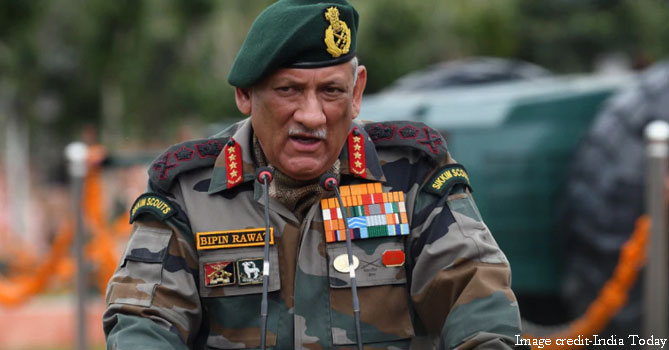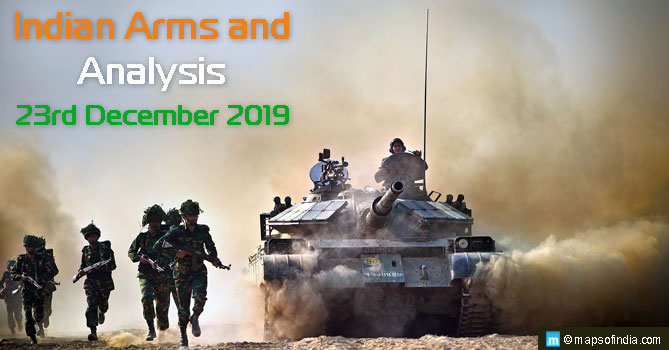
On 1 January 2020, General Bipin Rawat, the former Indian Army Chief, took over as India’s first Chief of Defence Staff (CDS), a four-star rank officer.
Gen Rawat served as the Army Chief for three years and was due for retirement on 31 December 2019. The government gave him an extension and appointed him India’s first CDS.
With the new position comes the new look. Gen Rawat will henceforth be wearing a peaked cap instead of his usual hat, generally worn by Sikkim Scouts and the Gorkha Battalion. His peaked cap, rank badge and accoutrements will represent the three services, as the CDS represents the three services, and will report to the Raksha Mantri.
The newly appointed Army Chief General Naravane will carry on the same functions and fulfil all responsibilities assigned to the Army Chief position.
The long road to CDS
For a long time, India has debated the position of CDS. In 1982, the then Army Chief General Krishna Rao mooted the need to create a post of CDS. It was seriously considered after the Kargil War in 1999 when the Kargil Review Committee in 2001 suggested the creation of the post of CDS.
However, there was a section within the political and bureaucratic establishment that was opposed to the idea. They feared it would hand over too much power to one person, as the post oversaw the three service chiefs. Therefore, not much action was taken despite recommendations from several committees.
In 2012, the Naresh Chandra Committee came out with its recommendations, as did the Lt. Gen DB Shekatkar Committee in 2016.
PM Modi has always been open to the creation of the CDS post. In 2017, the Cabinet Committee for Security (CCS) took up the matter to expedite the process.
Why Chief of Defence Staff?
Globally, warfighting capabilities have undergone drastic changes from the earlier conventional wars. The defence forces of countries like the United States, Russia, China, France, UK, and others have modernised to conduct network-centric warfare across theatres.
Today’s battle outcomes rely on the quality of Intelligence, Surveillance, Target Acquisition, and Reconnaissance (ISTAR) and the efficiency of coordination of operations among all the three service arms – Army, Navy and Air Force, in real-time.
The government has initiated a programme to make the defence forces leaner, meaner, and thinner by reducing the non-combatant personnel, modernisation, and mechanisation of forces.
The position of the Chief of Defence Staff is expected to bring greater coordination between the three arms and theatre commands like the Strategic Forces Command (SFC) – India’s Nuclear Command. The CDS will work closely with the Raksha Mantri and the Ministry of Defence in laying the road map for the rapid modernisation, acquisition, and training of all three services.
The concept of Integrated Battle Groups (IBG) has been promoted actively by Gen Rawat. The IBG is designed for a quick offensive response using land and air assets in focused areas of conflict. It picks up from the ‘Cold Start’ doctrine initiated under Gen K Sundarji, the former Army Chief in the 80s. Under Gen Rawat as CDS, IBG is expected to be honed into a mean fighting machine.
The defence forces have traditionally suffered from inter-services rivalry and bureaucratic red tape. General Rawat is expected to address these issues and ensure higher transparency and coordination in operations between the three services.
General Bipin Rawat – An Officer and a Gentleman
Gen Bipin Rawat was born on 16 March 1958, in Pauri, Uttarakhand. Few know Gen Bipin Rawat comes from an illustrious military family. Born in Pauri in Garhwal, Gen Rawat is the son of Lieutenant General Lakshman Singh Rawat, who retired as Vice Chief of Amy Staff in 1988.
He studied at Cambrian Hall in Dehradun before shifting to St. Edwards School in Shimla. He joined the National Defence Academy (NDA) before heading on to the Indian Military Academy (IMA), where he was awarded the Sword of Honour.
On 16 December 1978, he was commissioned into the 5th Battalion of the 11 Gorkha Rifles, his father’s unit. Later, Gen Rawat commanded a battalion during the 1987 skirmish with China, at Line of Control in Sumdorong Chu Valley.
Gen Rawat has wide exposure in high altitude warfare and counter-insurgency operations. His long career includes commanding a Brigade during a UN Mission to the Democratic Republic of Congo, commanding the 19 Infantry Div in J&K, and later heading the crucial III Corp in Nagaland, before taking over as Vice Chief of Army. He took over as the Army Chief on 31 December 2016 and Chief of Defence Staff on 1 January 2020.
Gen Rawat has a reputation of a tough hands-on officer with an excellent strategic mind. His long experience across critical commands will serve India well as the nation evolves to the next level of strategic power.





